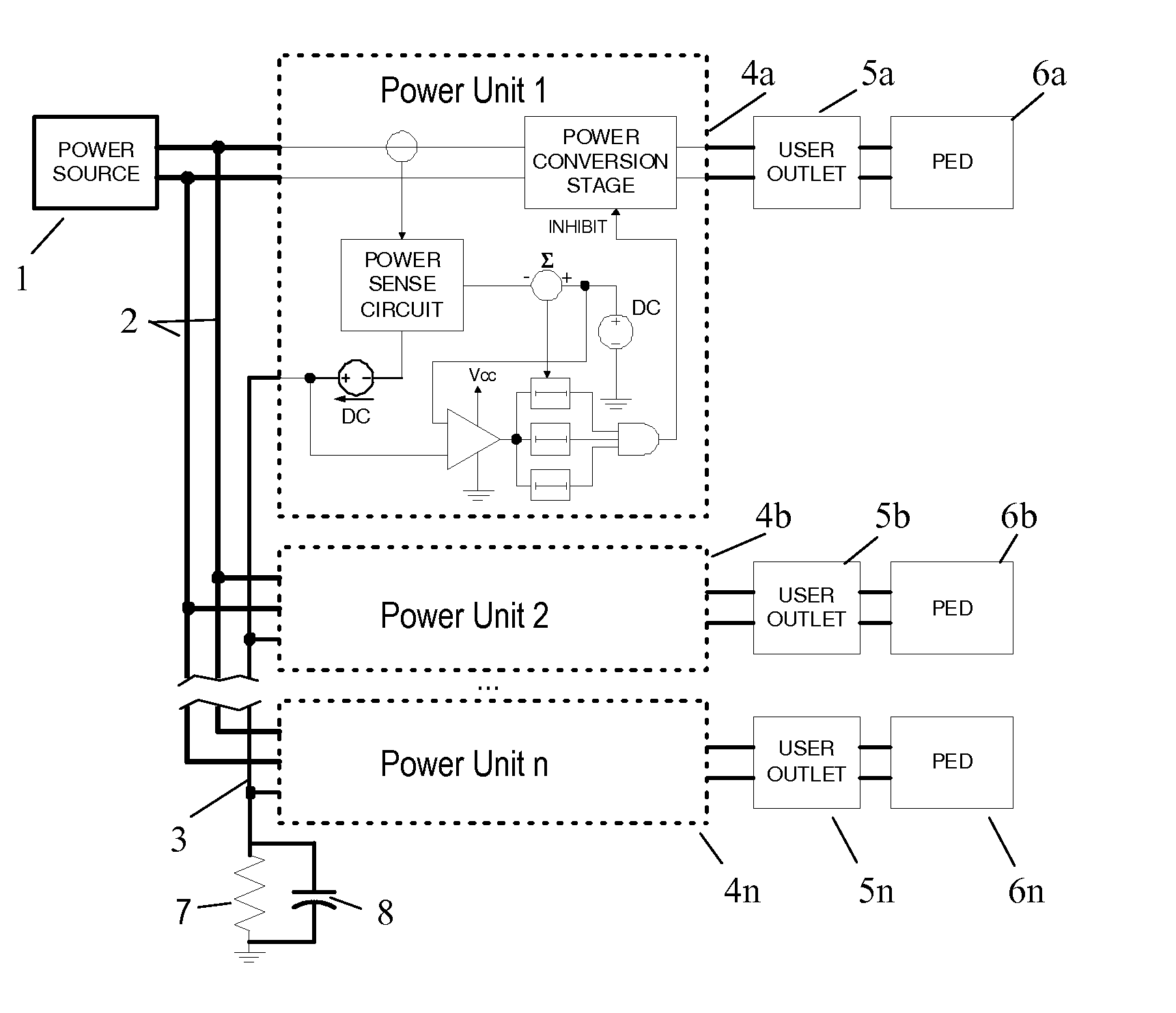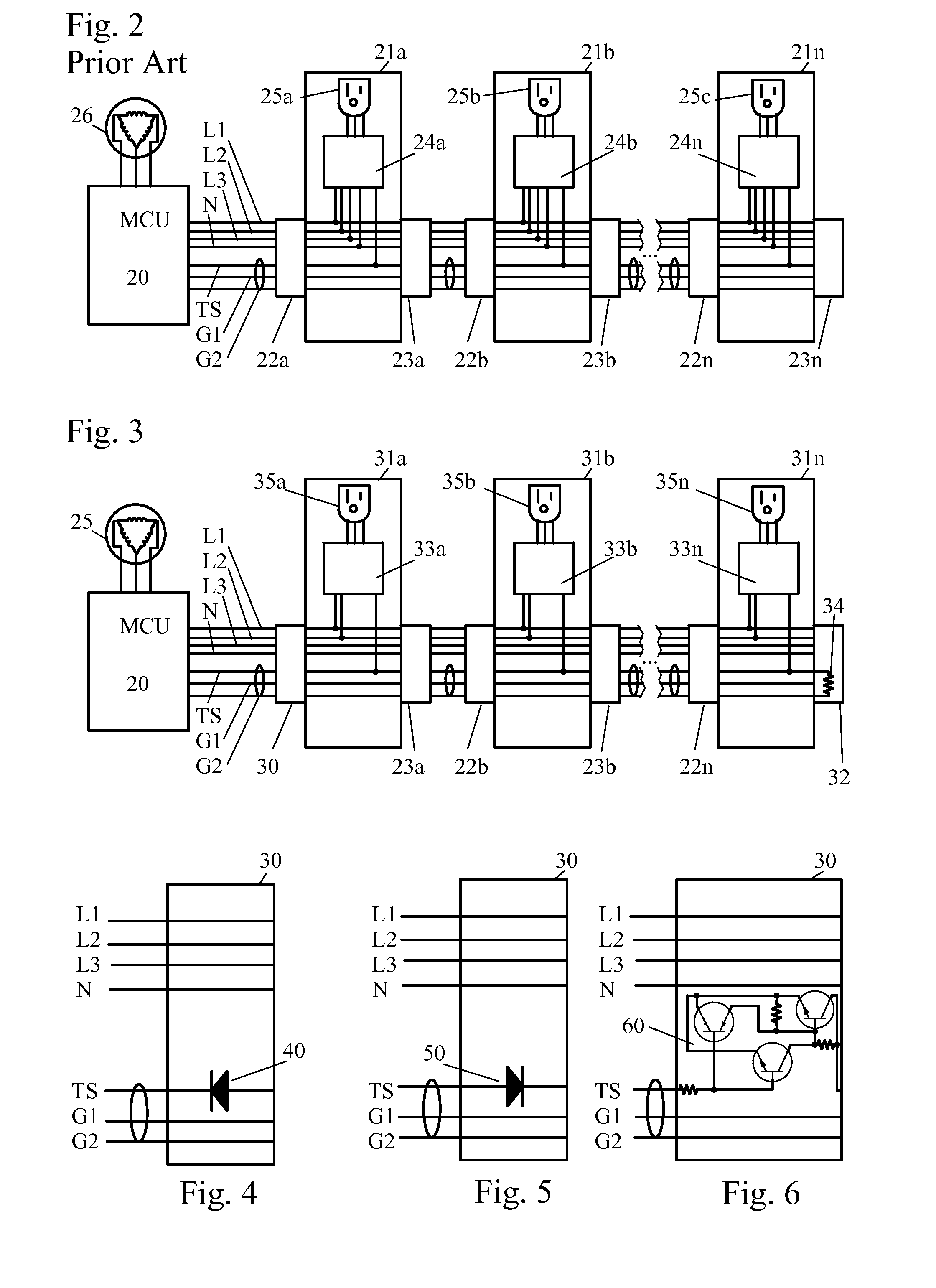Load Distribution System and Power Management System and Method
a load distribution and load technology, applied in the field of power supplies, can solve the problems of inability to adapt or scale to various deployment scenarios, limited power available from the power source, and usually wasted capacity, and achieve the effect of precise power control and easy adaptability
- Summary
- Abstract
- Description
- Claims
- Application Information
AI Technical Summary
Benefits of technology
Problems solved by technology
Method used
Image
Examples
embodiment 1
DC Current Monitor Bus Control
[0030]In this embodiment, each power unit 4a-4n adds a current to this monitor bus 3 proportional to the current it is drawing from the power bus 2. In this embodiment the monitor bus 3 is grounded through a reference resistor 7 at one point. This point could be at one end of the branch, or in a master control unit which supplies the power to the branch, or in one of the power units 4a-4n, or anywhere else on the branch as desired. The reference resistor 7 thus serves as a simple, system level threshold determination device. As current is added to the monitor bus 3 by the power units 4a-4n, a voltage drop is generated by the reference resistor 7 which is proportional to the total current being drawn from power bus 2 by all of the power units 4a-4n. If desired for noise decoupling, a capacitor 8 can be provided in parallel with resistor 7 as shown in FIG. 1.
[0031]FIG. 7 shows a detail of a representative single power unit 4a from FIG. 1. It should be not...
embodiment 2
Pulse Rate Monitor Bus Control
[0061]Referring to FIGS. 8 and 9, the basic system of this embodiment is the same as described for the first embodiment, and the common elements will not be separately described here.
[0062]FIG. 9 shows a detail of a representative single power unit 4a from FIG. 8. As with the first embodiment, the power unit 4a has a power conversion stage 81, which takes electrical power on its input 80 which is connected to power bus 2 (say 115VAC at 400 Hz), and converts it to a different voltage and / or frequency (say, 120VAC 60 Hz) at an output 82 which connects to outlet 5a. The power conversion stage 81 can be shut off by a signal on INHIBIT line 94.
[0063]The current in the power conversion stage 81 is measured by a sensor 83, which is input to power sense circuit 84. The example shows sensor 83 sensing current in the input 80 to power conversion stage 81, so that the sensor 83 directly reads current drawn from the power bus 2. It will be understood that the curre...
embodiment 3
Control by Digital Signals on Digital Monitor Bus
[0079]In another possible implementation, the analog share bus is implemented digitally by any one of a number of common communications buses, such as CAN bus or Ethernet. Each unit would report its load current, and each unit could then know all the currents. Any type of algorithm could be implemented to drop of users for load shedding. The first user to be dropped could be the user who has been on the longest time, the user who has consumed the least watt-hours, the user who has consumed the most watt-hours, etc.
Tri-State Signal Interface
[0080]Legacy aircraft cabin power systems employ a centrally generated tri-state signal that is daisy chained between units. FIG. 2 shows a system of the prior art in such an arrangement. The legacy system has takes three-phase 400 Hz AC power from the aircraft generator 26, and routes the power from generator 26 through a Master Control Unit (MCU) 20 to a three-phase power bus with lines L1-L3 and ...
PUM
 Login to View More
Login to View More Abstract
Description
Claims
Application Information
 Login to View More
Login to View More - R&D
- Intellectual Property
- Life Sciences
- Materials
- Tech Scout
- Unparalleled Data Quality
- Higher Quality Content
- 60% Fewer Hallucinations
Browse by: Latest US Patents, China's latest patents, Technical Efficacy Thesaurus, Application Domain, Technology Topic, Popular Technical Reports.
© 2025 PatSnap. All rights reserved.Legal|Privacy policy|Modern Slavery Act Transparency Statement|Sitemap|About US| Contact US: help@patsnap.com



